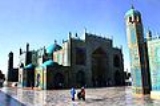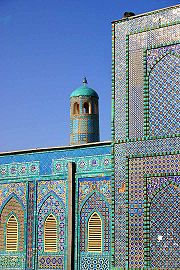
Shrine of Hazrat Ali
Encyclopedia
The Shrine of Hazrat Ali, also known as the Blue Mosque, is a mosque in Mazari Sharif, Afghanistan
. It is one of the reputed burial places of Ali
. It is the building which gives the city in which it is located, Mazari Sharif (meaning "Tomb of the Exalted") its name.
According to Shi'a Muslim belief, Ali
was originally buried by his two sons, Hasan
and Husayn
in an undisclosed location, which was later made known by the great, grandson of Husayn and Sixth Shi'a Imam
, Ja'far as-Sadiq - as the grave that is found within Imam Ali Mosque
in Najaf
, Iraq
.
, some of Ali's followers worried that his body would be desecrated by his enemies, and they placed his remains on a white female camel. Ali's followers traveled with the camel for several weeks, until the camel ultimately fell to the ground exhausted. The body was then reburied where the camel fell. The body was said to be rediscovered there in the 12th century.
 According to tradition, Mazari Sharif owes its existence to a dream. At the beginning of the 12th century, a local mullah had a dream in which Ali bin Abi Talib, the prophet's cousin and son-in-law and first Shia Imam and one of the four Rightly Guided Caliphs appeared to reveal that he had been secretly buried near the city of Balkh
According to tradition, Mazari Sharif owes its existence to a dream. At the beginning of the 12th century, a local mullah had a dream in which Ali bin Abi Talib, the prophet's cousin and son-in-law and first Shia Imam and one of the four Rightly Guided Caliphs appeared to reveal that he had been secretly buried near the city of Balkh
. After investigation and the opening of the tomb, the Seljuk sultan Sanjar ordered a city and shrine to be built on the spot, where it stood until its destruction by Genghis Khan
. Although later rebuilt, Mazar stood in the shadow of its neighbor Balkh, until that city was abandoned in 1866 for health reasons.
Some of the artwork on the Blue Mosque.
The Seljuq dynasty
sultan Ahmed Sanjar
rebuilt the first shrine at this location. it was destroyed by Genghis Khan
in the invasion around 1220. It was rebuilt in the 15th century by Husain Baiqara. Most of the shrine's decorations, however, are the result of modern restoration work. One of the few remaining artifacts from the earlier shrine is a marble slab inscribed with the words, "Ali, Lion of God."2313
A site plan of the location made in the 1910s shows that there had earlier been a smaller walled precinct in the mosque, which were razed to create parklands later, although the portals to this precincts still remain as gateways for the shrine.
Tombs of varying dimensions were added for a number of Afghan political and religious leaders over the years, which has led to the development of its current irregular dimensions. These include the square domed tomb of Amir Dost Muhammad, Wazir Akbar Khan
and a similar structure for Amir Sher Ali
and his family.
Afghanistan
Afghanistan , officially the Islamic Republic of Afghanistan, is a landlocked country located in the centre of Asia, forming South Asia, Central Asia and the Middle East. With a population of about 29 million, it has an area of , making it the 42nd most populous and 41st largest nation in the world...
. It is one of the reputed burial places of Ali
Ali
' |Ramaḍān]], 40 AH; approximately October 23, 598 or 600 or March 17, 599 – January 27, 661).His father's name was Abu Talib. Ali was also the cousin and son-in-law of the Islamic prophet Muhammad, and ruled over the Islamic Caliphate from 656 to 661, and was the first male convert to Islam...
. It is the building which gives the city in which it is located, Mazari Sharif (meaning "Tomb of the Exalted") its name.
According to Shi'a Muslim belief, Ali
Ali
' |Ramaḍān]], 40 AH; approximately October 23, 598 or 600 or March 17, 599 – January 27, 661).His father's name was Abu Talib. Ali was also the cousin and son-in-law of the Islamic prophet Muhammad, and ruled over the Islamic Caliphate from 656 to 661, and was the first male convert to Islam...
was originally buried by his two sons, Hasan
Hasan ibn Ali
Al-Hasan ibn ‘Alī ibn Abī Tālib is an important figure in Islam, the son of Fatimah the daughter of the Islamic prophet Muhammad, and of the fourth Caliph Ali ibn Abi Talib. Hasan is a member of the Ahl al-Bayt and Ahl al-Kisa...
and Husayn
Husayn ibn Ali
Hussein ibn ‘Alī ibn Abī Ṭālib was the son of ‘Alī ibn Abī Ṭālib and Fātimah Zahrā...
in an undisclosed location, which was later made known by the great, grandson of Husayn and Sixth Shi'a Imam
Imamah (Shi'a doctrine)
Imāmah is the Shia doctrine of religious, spiritual and political leadership of the Ummah. The Shīa believe that the A'immah are the true Caliphs or rightful successors of Muḥammad, and further that Imams are possessed of divine knowledge and authority as well as being part of the Ahl al-Bayt,...
, Ja'far as-Sadiq - as the grave that is found within Imam Ali Mosque
Imam Ali Mosque
The Imām ‘Alī Holy Shrine , also known as Masjid Ali or the Mosque of ‘Alī, located in Najaf, Iraq, is the third holiest site for some of the estimated 200 million followers of the Shia branch of Islam. ‘Alī ibn Abī Tālib, the cousin of Muhammad, the fourth caliph , the first Imam is buried here...
in Najaf
Najaf
Najaf is a city in Iraq about 160 km south of Baghdad. Its estimated population in 2008 is 560,000 people. It is the capital of Najaf Governorate...
, Iraq
Iraq
Iraq ; officially the Republic of Iraq is a country in Western Asia spanning most of the northwestern end of the Zagros mountain range, the eastern part of the Syrian Desert and the northern part of the Arabian Desert....
.
History of the Mosque
The story of the founding of the shrine indicates that, shortly after the murder of Ali and the burial of his body at Najaf, near BaghdadBaghdad
Baghdad is the capital of Iraq, as well as the coterminous Baghdad Governorate. The population of Baghdad in 2011 is approximately 7,216,040...
, some of Ali's followers worried that his body would be desecrated by his enemies, and they placed his remains on a white female camel. Ali's followers traveled with the camel for several weeks, until the camel ultimately fell to the ground exhausted. The body was then reburied where the camel fell. The body was said to be rediscovered there in the 12th century.

Balkh
Balkh , was an ancient city and centre of Zoroastrianism in what is now northern Afghanistan. Today it is a small town in the province of Balkh, about 20 kilometers northwest of the provincial capital, Mazar-e Sharif, and some south of the Amu Darya. It was one of the major cities of Khorasan...
. After investigation and the opening of the tomb, the Seljuk sultan Sanjar ordered a city and shrine to be built on the spot, where it stood until its destruction by Genghis Khan
Genghis Khan
Genghis Khan , born Temujin and occasionally known by his temple name Taizu , was the founder and Great Khan of the Mongol Empire, which became the largest contiguous empire in history after his death....
. Although later rebuilt, Mazar stood in the shadow of its neighbor Balkh, until that city was abandoned in 1866 for health reasons.
Some of the artwork on the Blue Mosque.
The Seljuq dynasty
Seljuq dynasty
The Seljuq ; were a Turco-Persian Sunni Muslim dynasty that ruled parts of Central Asia and the Middle East from the 11th to 14th centuries...
sultan Ahmed Sanjar
Ahmed Sanjar
Ahmad Sanjar Ahmad Sanjar Ahmad Sanjar (Mu'iz ud-Dīn Ahmad-e Sanjar; was the sultan of the Great Seljuq Empire from 1118 to 1153. He was initially the sultan of Khorasan until he gained the rest of the territory upon the death of Muhammad I....
rebuilt the first shrine at this location. it was destroyed by Genghis Khan
Genghis Khan
Genghis Khan , born Temujin and occasionally known by his temple name Taizu , was the founder and Great Khan of the Mongol Empire, which became the largest contiguous empire in history after his death....
in the invasion around 1220. It was rebuilt in the 15th century by Husain Baiqara. Most of the shrine's decorations, however, are the result of modern restoration work. One of the few remaining artifacts from the earlier shrine is a marble slab inscribed with the words, "Ali, Lion of God."2313
A site plan of the location made in the 1910s shows that there had earlier been a smaller walled precinct in the mosque, which were razed to create parklands later, although the portals to this precincts still remain as gateways for the shrine.
Tombs of varying dimensions were added for a number of Afghan political and religious leaders over the years, which has led to the development of its current irregular dimensions. These include the square domed tomb of Amir Dost Muhammad, Wazir Akbar Khan
Akbar Khan
Amir Akbar Khan Amir Akbar Khan Amir Akbar Khan (1816 – 1846;, born as Mohammad Akbar Khan and famously known as Wazir Akbar Khan, was an Afghan Prince, a general, a tribal leader and Emir. He was active in the First Anglo-Afghan War, which lasted from 1839 to 1842...
and a similar structure for Amir Sher Ali
Sher Ali Khan
Sher Ali Khan was Amir of Afghanistan from 1863 to 1866 and from 1868 until his death in 1879. He was the third son of Dost Mohammed Khan, founder of the Barakzai Dynasty in Afghanistan....
and his family.

